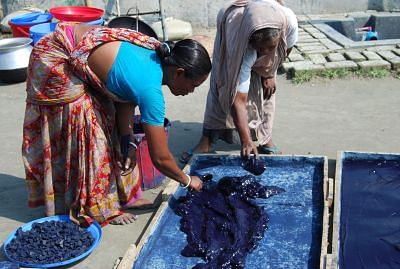Self-owned social enterprise

Purnee and Nirmola are drying their Indigo.
Four years ago, Monju Rani of Rangpur Sadar was struggling to earn a livelihood as a worker in a local tobacco factory. Momtaz of Polashbari-Gaibandha had a hard time trying to ensure regular meals as a widow. Sona Rani of Chirirbandar-Dinajpur was indebted because her rickshaw mechanic husband could not earn enough to ensure their children's education. Sumantho of Rangpur Sadar was planning to work as a night guard in Rangpur town to earn money for bearing his education expense.
But now, their lives have been transformed -- they have become self-reliant. Monju is leading a group of 39 women who are involved in shibori (Japanese tie-die technique). Momtaz is heading an artisan's group producing khetaor quilts. Sona Rani is a master artisan involved in reviving famous lohari technique of khetaor quilts and Sumantho is leading indigo production in which around 400 households are involved.
They have formed the "Nijera Cottage and Village Industries" (NCVI), a workers and artisans owned social enterprise, under which around 2,000 families are working and earning their livelihoods. For them, NCVI is an inspiration to participate in the market and an opportunity to break the cycle of poverty.
It started to take shape as a social enterprise in 2008 when NCVI was formally registered as a company. The enterprise is presently run by 8 directors representing groups that are working for khetaor quilt, shibori, natural dying, and indigo and honey production in Rangpur, Dinajpur, Nilphamari, Lalmonirhat and Gaibandha. The directors have been elected based on their leadership and ability to inspire others, their expertise and contribution to skill development and the trust they command within their communities.
NCVI is presently working as an umbrella organisation for the groups to interact with markets. Social and Economic Transformation of the Utra-Poor (SETU) project of CARE Bangladesh funded by Shiree is collaborating with NCVI in linking with high-end markets with their brand "Living Blue." The broader vision of NCVI is in tune with the defining features of "social economy" that aims to: drive up productivity and competitiveness; contribute to socially inclusive wealth creation; enable individuals and communities to work towards regenerating their local neighbourhoods; show new ways to include the poorest in the market; and help develop an inclusive society and active citizenship.
The brand "Living Blue" stands for high quality hand-made products meant for high-end markets. It is about fair trade where the artisans not only get a fair wage and democratically manage and run their own businesses, but also have total control over profits. The surplus generated by this contributes to the general well-being of local communities and helps create sustainable social, cultural and economic life.
It was like an "improbable dream" to brand development experts in 2008 when NCVI started to promote their brand. Using the "Living Blue" brand, this social enterprise was able to connect the artisans from "bottom of the pyramid" with the high-end market in only 4 years. It is now collaborating with Couleur Garance (France), Sally Campbell (Australia), Plantation House (India), Maiwa (Canada) and many more. It has also been collaborating with a number of top brands of Europe that are famous for scarves. These business organisations are selling products using the "Living Blue" brand.
The sales and profit generated by NCVI have created enthusiasm amongst artisans and workers. NCVI gives bonuses to the member artisans and producer groups. A quick survey by NCVI revealed that the additional money was used by the families in many innovative ways to strengthen livelihoods -- goat, sheep and cattle purchases; money for children's school fees; repair and improvement of dwellings; buying of rickshaw vans; starting oil and rice husking businesses, etc. A number of them have invested their money in savings groups, others paid off loans and some have invested in sharecropping.
Salma Begum, Managing Director of NCVI, is proud of her role in the company. She said: "We are the workers of the company, we are also the owners. This company is meant for profit, but the profit is for the welfare of workers and artisans. No worker and artisan in our company will remain poor. We are proud of our company." She dreams of including 5,000 artisans in her organisation in two years.
NCVI is offering a model that ensures sustainable inclusion of extremely poor in markets. It has set a unique trend for development actors that are focusing on creating economic opportunities for the poorest. Creating market opportunities for craft work is not new, but what is new is that artisans own the surplus generated from the business. This is reinvested for the business as well as socio-economic well being of the workers, thereby assisting a large number of beneficiaries to graduate out of extreme poverty. A lot of discussions and debates are taking place, saying that participation in the lowest tier of the market is not enough for the poorest households. Private sector corporations should be encouraged to provide primary producers with an equity stake in the company.
Suggestions have been made that commercial ventures run by NGOs should be restructured into microenterprises jointly owned by their supply chain. Monu Rani, Momtaz, Sona Rani, Sumantho, with others from villages of the northwest, have shown how to do this with the NCVI model -- an inspiration that shows again that poverty eradication at a large scale is possible if rural local economy is built.

 For all latest news, follow The Daily Star's Google News channel.
For all latest news, follow The Daily Star's Google News channel. 



Comments